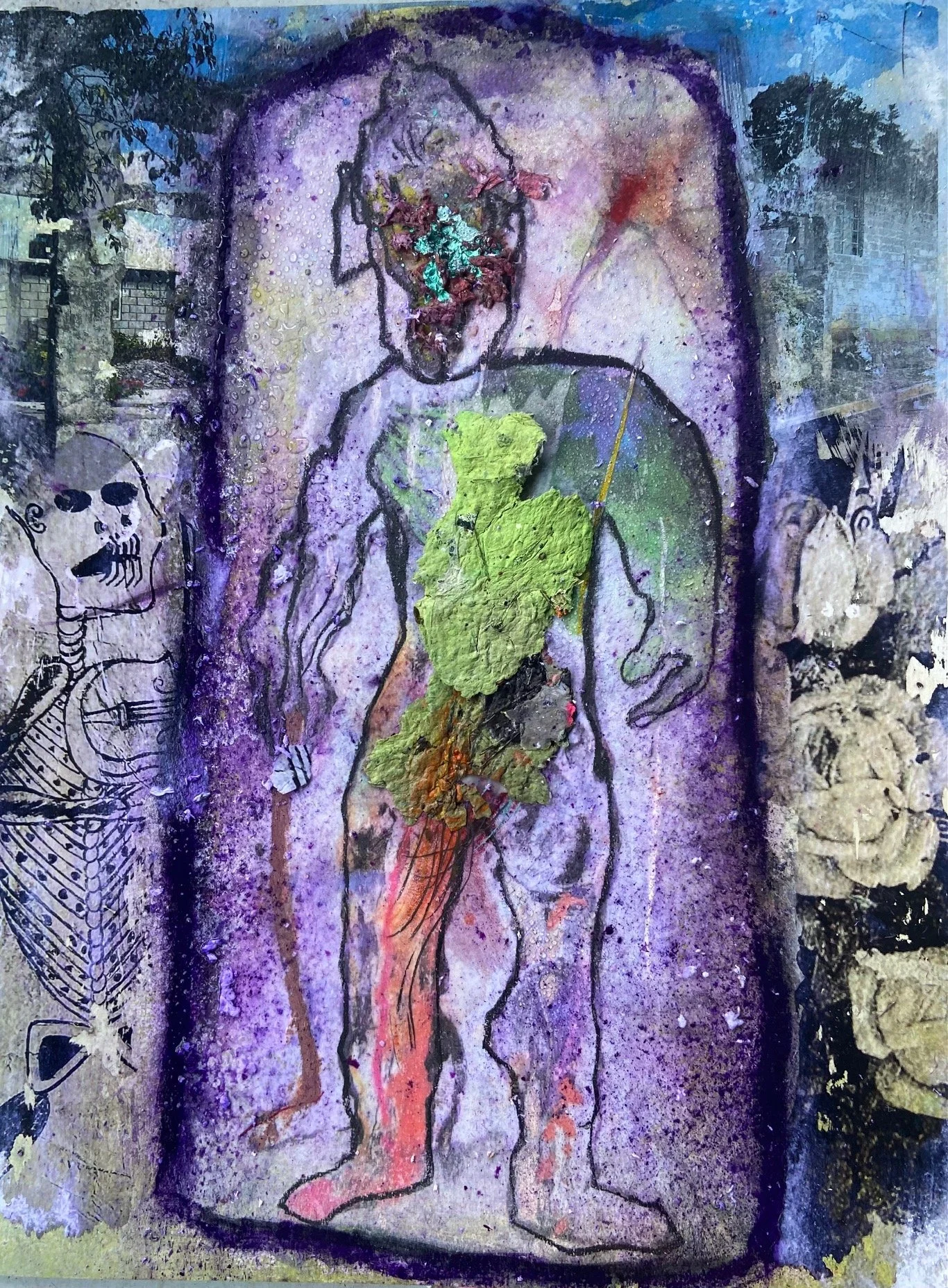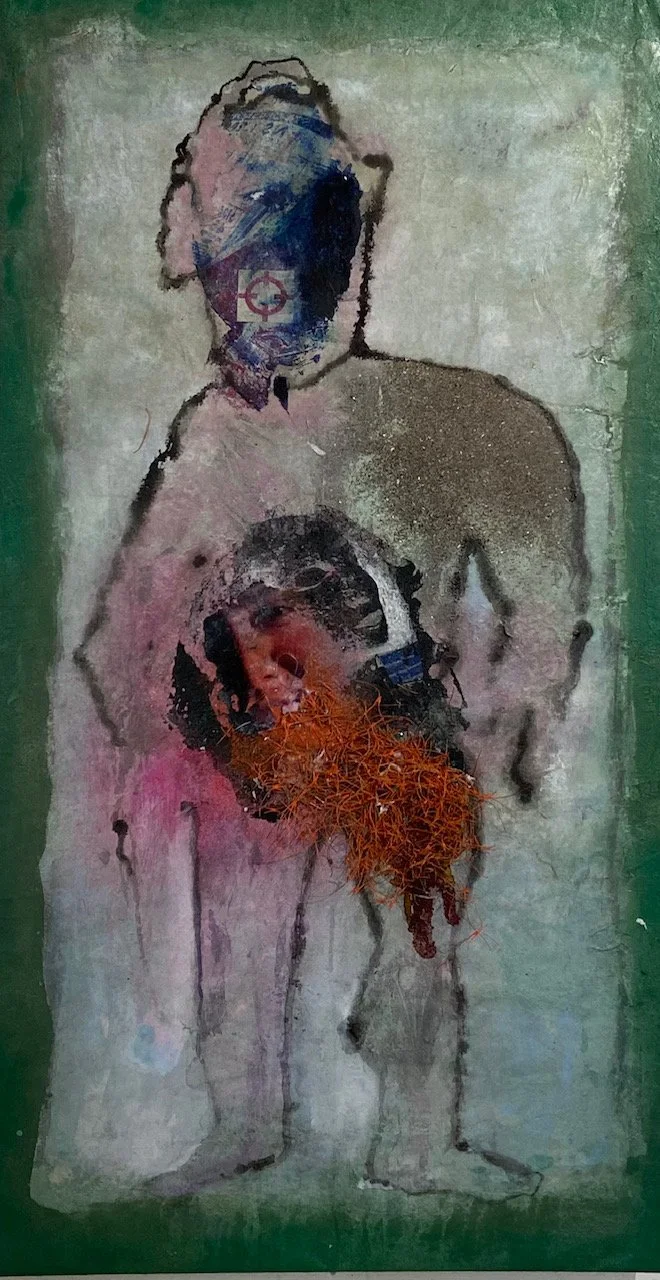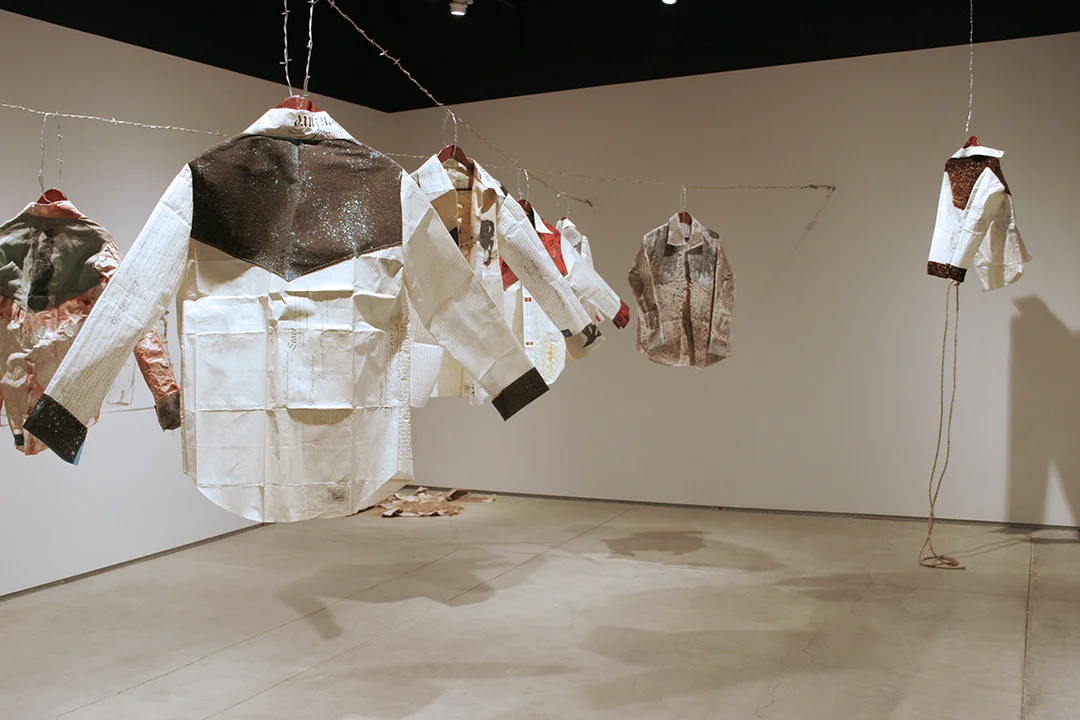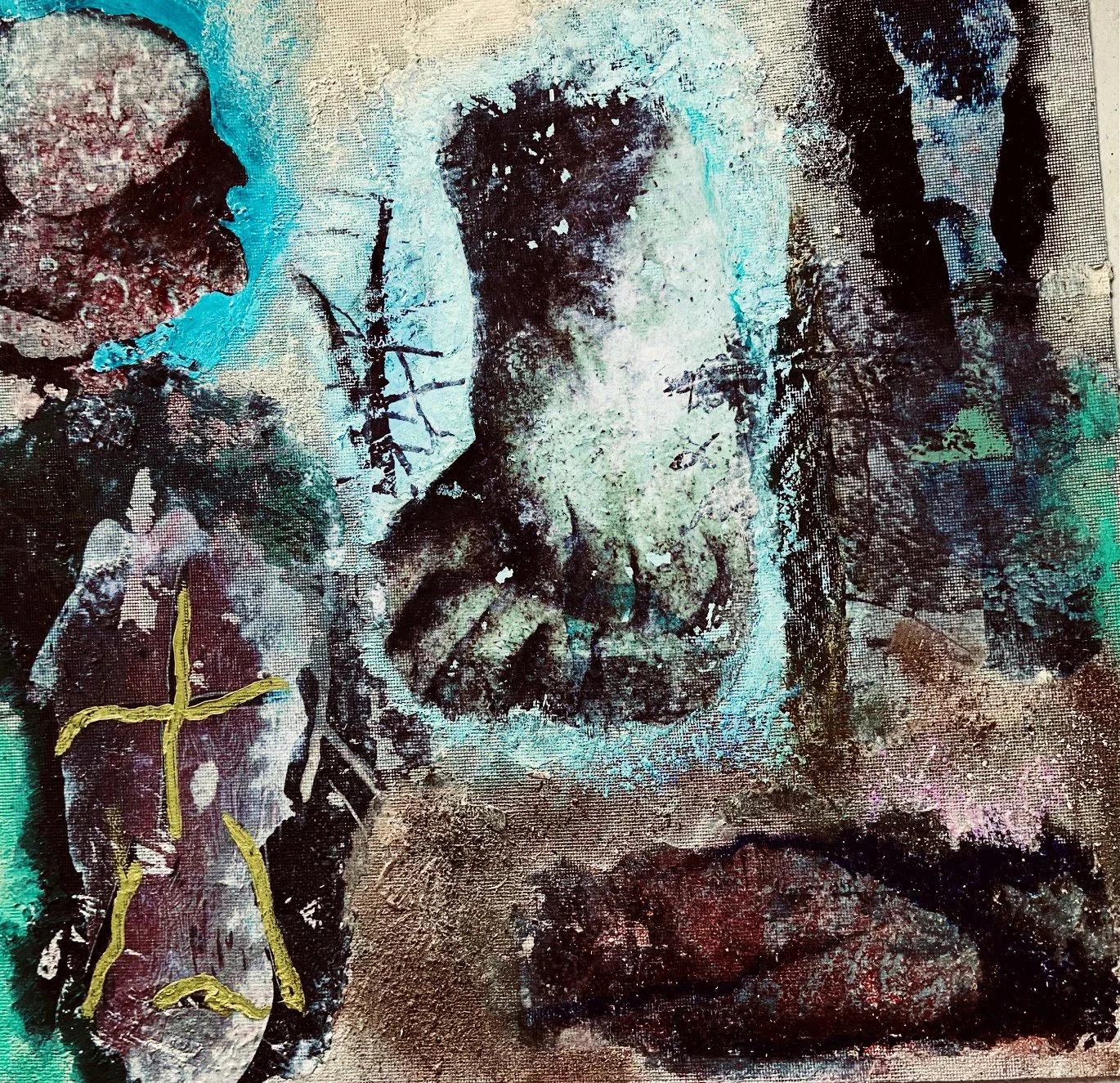EMBODIMENTS
El Grand Duende (2019)
Acrylic, oil, powdered pigment, seeds, print transfer, tree branch on fiberglass mesh
72”x 36”
DUENDE (San Pablo) 2020
Oil, acrylic, charcoal, on fiberglass mesh
42”x24”
Oaxaca, Mexico
El Grand Duende is based on an image taken from a Spanish colonial text found in Oaxaca, Mexico. It represents a gnome-like figure dressed in a plant-like jumpsuit with a headdress. This enigmatic figure intrigued me because of its mythical allusions. The details of the figure and its costume reminded me of the leaded separations of a stained glass window found in Catholic cathedrals. I transferred a photocopy of the image onto fiberglass mesh and colorized it with acrylic and oil. The frame surrounding the image is ornamented with seeds and the beard is covered with shredded copper filaments. The entire piece is suspended on a curved tree branch.
THE DUENDE LITHOGRAPHS
In 2021, the same image resurfaced as inspiration for five color photolitho edition prints and single image intervention with multimedia coloring at La Buena Impression printshop in Oaxaca, Mexico.
El Duende (2021)
five color photolitho completed from La Buena Impression printshop Oaxaca, Mexico
30"x12"
El Duende (2021)
five color photolitho completed from La Buena Impression printshop Oaxaca, Mexico
30"x12"
El Duende (2021)
five color photolitho completed from La Buena Impression printshop Oaxaca, Mexico
30"x12"
El Duende (2021)
five color photolitho completed from La Buena Impression printshop Oaxaca, Mexico
30"x12"
El Duende (2021)
five color photolitho completed from La Buena Impression printshop Oaxaca, Mexico
30"x12"
El Duende (2021)
five color photolitho completed from La Buena Impression printshop Oaxaca, Mexico
30"x12"
Small Duendes
(TLACOLULA)
Small Duende, WOUNDED (2022)
Xerox and print transfer
23”X18”
El Duende (2021)
five color photolitho
edition of five completed from La Buena Impression pint photoshop Oaxaca, Mexico
30"x12"
El Duende (2021)
five color photolitho
edition of five completed from La Buena Impression pint photoshop Oaxaca, Mexico
30"x12"
El Duende (2021)
five color photolitho
edition of five completed from La Buena Impression pint photoshop Oaxaca, Mexico
30"x12"
Digital Prints
THE DUENDE PAINTINGS
DUENDE ANONIMO
Acrylic, oil, plastic debris, ashes, print transfer on polypropylene
44” x 22”
DUENDE SERIES (Saverio) 2022
Oil, acrylic, charcoal, crushed glass, earth, oil bar, print transfer on polypropylene cloth
48"X 27"
INFRADUENDE #1 2022
Mixed media on propylene
55” x 34”
Wall hanging
Cemetery is a tribute to the Russian Orthodox cemetery Sainte-Geneviéve-des-Bois, located in a suburb of Paris.
The funerary grounds houses a generation of Russian immigrants who fled the Bolshevik Revolution, their relatives, and more recently Rudolf Nureyev, the acclaimed ballet dancer who defected the Soviet Union in the 60’s.
This multilayered 4x8 feet collage contains an aggregate of gravesite images and monuments, texts in Cyrillic alphabet, vintage postcards, cloth and acetate print transfers encrusted with bark, earth and sediments of pigments in acrylic and oil on canvas. In the center is a window framing a short video of an old man meandering through the alleyways searching for a grave.
This assemblage pays homage to the memory and resting place of my father’s peers; White Russian army soldiers, some of which I met during my trips to Paris. Currently, Sainte-Geneviève-des-Bois is an endangered historic site, under threat of obliteration by the French government.
Cemetery (2019)
Acrylic, oil, fiberglass mesh, photographs, postcards, acetate prints, bark, paper debris, printed cloth, short video
CAT’S CRADLE
La Danza de la Pluma (2018)
Acrylic, oil, print transfer on fiberglass mesh
48'' x 48''
Untitled Tapestry Hanging (2018)
Porfirio Gutierrez Wool, bird feathers, wooden adornments
48'' x 48''
The collaborative installation "Cat’s Cradle” features a hanging by Porfirio Gutierrez, a master weaver from Oaxaca, Mexico and a scroll of portraits from Teoticlan de Valle. The multimedia installation was commissioned by MACO (Museo de Arte Contemporaneo de Oaxaca) for the exhibition “Under the Cobalt Blue Sky” in which fifteen international fine artists partnered with indigenous artisans from the region of Oaxaca in December 2018.
The subject of the piece was an interaction between a group of dancers who yearly performed a ritual dance “La Danza de la Pluma” that commemorates the struggle between the conquering Spaniards and the indigenous population of Mexico. Strands of red wool emerge from the foreheads of each dancer’s portrait, connecting to the central eye of an adjacent wool tapestry, creating a symbolic bridge between both hanging artworks.
The floor space between the installation is strewn with earth, ashes, and pairs of the dancers’ worn sandals, accompanied by identifying labels of each name in Cyrillic alphabet, a choice of my collaborator in tribute to my ethnicity.
NUDE DESCENDING A STAIRCASE
Seeing my own image reflected in a shattered mirror brought to mind a cubistic reference of Duchamp’s iconic masterpiece “Nude Descending A Staircase No.12". I decided to turn the concept of this painting on its head and transform it into a thoroughly narrative piece based on my own life.
On a large expanse of fiberglass mesh-my ground of preference for several years-I depicted my fractured reflection in oil and acrylic and framed it with a cacophony of autobiographical snippets, collaged documents, polaroids and smaller mixed media imagery with oil, acrylic, earth, powdered pigment and paper debris.
My left arm holds an iPhone capturing my nude body, while my raised right arm is disappears into the landscape of the skyline overlooking our home.
HOMUNCULUS
HOMUNCULUS is a double sided "tapestry-like" hanging depicting a generic human figure splayed openly on a colorized ground of fiberglass mesh. It is inspired by a medical illustration found in a Persian manuscript by Mansur Ibn Muhammad from 1390. The central image was enlarged and transferred reprographically onto a pearlescent painted mesh then drawn and painted with acrylic and bright rivulets of oil and enamel paint, enhancing the vascular system as visualized by the original artist .The central figure is surrounded by smaller images of anatomical details of body parts derived from European anatomical treatises also painted in acrylic & oil paint.
This interesting juxtaposition of styles creates a contrast of the schematic, symmetrical almost carved feeling of the Persian illustration with the European illusionistic anatomical rendition.
Homunculus (2019)
86” x 48”
Homunculus (2019)
86” x 48”
MANZANAR KIMONO
After visiting Manzanar National Park, formerly Manzanar War Relocation Camp, where many thousands of Japanese Americans were incarcerated during WWII, I felt compelled to make this monumental-scale kimono, dedicated to those who suffered relocation, loss and betrayal by the U.S. government.
The front, back and sleeves of this memorial garment are imprinted with enlargements that I photographed while visiting the internment camp.
The back of the kimono displays an image of the guard tower that still stands ominously on the grounds. The front reveals pictures of rusting sleeping cots from the barracks interspersed with views of the Memorial monument. Photographs of fragments of sculptural work by artist, Ruth Asawa, who was interned at Manzanar, appear on the sleeves.
The fabric of the kimono is a thin polypropylene material commonly known as weed blocker. The images were transferred to the garment through the use of photocopies coated with acrylic gel medium, then pressed against the fabric. Subsequently, the surface is highlighted with acrylic paint and charcoal then rubbed with earth and ashes to provide additional texture and depth.
The enormous scale of the kimono (11’ x 6’) symbolizes the phenomenal endurance, creativity and tenacity of more than 110,000 Japanese Americans who were interned during WWII.
Manzanar Kimono (Front) (2014)
Print transfer, acrylic, ashes on propylene fabric
11' x 6'
Manzanar Kimono (Back) (2014)
Print transfer, acrylic, ashes on propylene fabric
11' x 6'
THE GARZA SERIES
José Garza is a civil servant that I met in a municipal pool about twenty years ago. I was struck by his austere demeanor which reminded me of the Spanish painter, Zurbarán. Soon after, I completed his portrait and later, our artistic relationship developed into formal standing nude portraits. Subsequently, he was the main subject matter of a series of monumental drawings that were recently compiled into a publication called Side Life. He continues to inspire my figurative work in the recent piece Nadie and an ongoing series of Garza Ghost mixed media works.
Old Man 3
Acrylic, charcoal and powdered pigment on Synskin
82” x 45”
Photo credit: Craig Havens
Garza Series Nadie (2020)
Oil, acrylic, earth, silver leaf on synskin
75” x 24”
Shall #2 (2009)
Acrylic, earth, polyblend, crushed glass on synskin
24" x 72"
Old Man #1 (2006)
Charcoal, acrylic, pastel, graphite, powdered pigment on synskin
80” x 48”
Old Man #3B (Phantom) (2005)
Charcoal, acrylic, ashes, powdered pigment, pastel on synskin
80” x 46”
Old Man #4 (2005)
Charcoal, acrylic, powdered pigment, earth on synskin
85” x 45”
Old Man #5 (2005)
Charcoal, acrylic, ashes, powdered pigment, pastel on synskin
80” x 46”
Lost In Hollywood
The central figure, Vasilisa, is an image of a young girl borrowed from a Russian folktale, illustrated by the well-known artist Ivan Bilibin. During our immigrant years in Argentina my Russian-born mother painted exact replicas of Bilibin’s image of Vasilisa carrying a glowing skull as a torch given to her by a witch who lives in a hut supported by chicken legs.
As a tribute to Olga, my mother, I have replicated an enlarged version of Vasilisa on coarse yellow mesh used in the plastering process. This mesh resembles the thread technique of cross-stitching frequently used in folk costume. I have then colorized the image in translucent washes of acrylic, touches of opaque oil and dusted with thin layers of crush glass. Vestiges of street photography from the urban environment of Los Angeles surround Vasilisa, hence the name of the piece, Lost in Hollywood.
Lost in Hollywood (2016)
Acrylic, oil , crushed glass, print transfer on fiberglass mesh
84'' x 48''
PAPER COWBOY
The climate, terrain and history of Western United States profoundly affected me during my recent residency with Ucross Foundation in April 2011. Generally my work depicts the human body, but for this project I explore the trappings of a figure that has attained mythological stature in America - the cowboy. Here, drawings and fabrications of Western shirts and well-worn chaps represent the hardworking, lonesome nomad.
CHAPS 1-3 (2011) Acrylic, powdered pigment, ink on velum. 36" x 24"
Cowboy shirt VII (Annie Proulx) (2011)
Acrylic, xerox transfer on linen, ink on vellum
40 in x 36 in
Cowboy shirt I (North Star) (2011)
Acrylic, earth on interfacing and 19th. century land deeds
38 in x 42 in
RECENT PORTRAITS
E . G . (2022)
Mixed media, oil bar, print transfer on fiberglass mesh
44” X 36”
THE LAST CRAFTSMAN (2022)
Oil/ acrylic/ powdered pigment/ charcoal/ sawdust/ print transfer on fiberglass mesh
LA TATE GALLERY
WEST ADAMS ART DISTRICT
LOS ANGELES
Protection (Chuck H) 2018
Acrylic, powdered pigment, print transfer on fiberglass mesh
36” X 30”
Gustavo (2015)
Acrylic, pastel on fiberglass mesh
30” x 28”
Kadija (2017)
Oil, acrylic, print transfer on mesh
40”x 35”
PAUL (2021)
Acrylic, oil, iron fillings, sand, silver leaf, print transfer on synskin
36” x 25”
Paul #2 (2021)
charcoal, pastel on book binding mesh
18”X24”
BT (2021)
charcoal, pastel, acrylic on synskin
16”x22”
Child and Mother (2015)
Acrylic, oil, print transfer on fiberglass mesh
27” x 32”
INFRAMUNDO
INFRAMUNDO #1 (2021)
Acrylic, oil, spray enamel, print transfer, powdered pigment on synskin
24”x26”
INFRAMUNDO #2 (2021)
Oil, acrylic, pint transfer, powdered pigment, earth on fiber glass mesh
24”x24”
Inframundo (Or Underworld) was inspired by the prone Christ figure placed in a tomb-like glass enclosure that resides in the Tlacolula cathedral near Oaxaca, Mexico. I depicted the Christ in a realist style reminiscent of Francisco de Zurbarán and other Spanish colonial paintings. The figure writhes from an enclosure of vestments adorned with religious motifs. At the left of the painting the face of a Zapotec man with feline eyes alludes to the indigenous population of the region. Vestiges of Zapotec writing and chicken legs hang from above the painting.
INFRAMUNDO (TLACOLULA) (2017)
Acrylic, oil, print transfer, earth, powdered pigment on fiberglass mesh.
35” x 69”
Cantinflas
Y La Suerte
Cantinflas y La Suerte was conceived in Mexico City approximately thirty years ago after witnessing a public tribute held at the Palacio de Bellas Artes after the passing of Mario Moreno, commonly known as Cantinflas. Cantinflas was an enormously popular actor featured in countless Mexican films over the course of half a decade. Referred to as the Charlie Chaplin of Mexico, he was a comic figure personifying the everyday tribulations of the common man.
The Cantinflas tapestry consists of twenty sheets of muslin imprinted with proceeds from the Lottería Nacional winning numbers and the iconic face of Cantinflas silkscreened in red. From each right eye emerges a chain tassel that trails to the floor strewn with glass crystals.
The Cantinflas tapestry was first shown in Mexico City in 1994 at the Centro Cultural San Angel. Subsequently, it was shown at CEARTE in Ensenada in 2017 as a memorial to the 25th anniversary of his death.
Cantiflas y La Suerte has recently been acquired by MACO the Museum of Contemporary Art in Oaxaca, Mexico.
Cantinflas y La Suerte (1994)
Screen print on cloth, chains and rock salt
3.6m x 3m
Cantinflas y La Suerte (1994)
Screen print on cloth, chains and rock salt
3.6m x 3m






















































